
N.S.B. Cosmic Center

Literary Adventures
This page will take you into pieces of literature that are carefully selected for their great content at the literary, scientific, or philosophical level. A short selection will be presented in full. A long one will be divided into sections that will be refreshed regularly. Emphasis and highlights are mostly ours, not made by the original author.
Here is our current selection:
The Fairy-Land of Science (1878) by Arabella Burton Buckley
Lecture 3.
The Aerial Ocean in Which We Live.
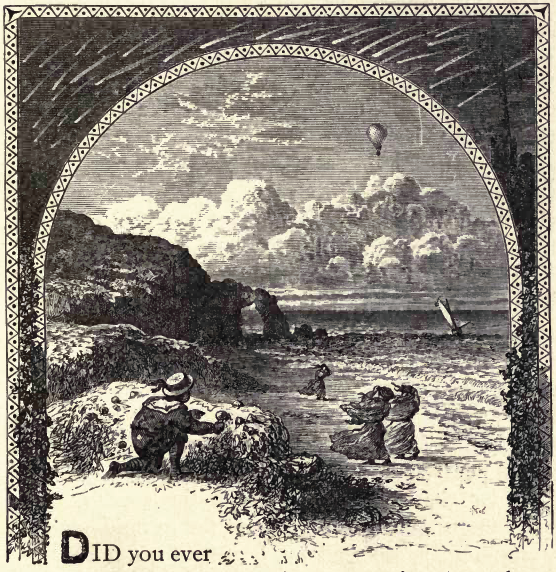
Did you ever sit on the bank of a river in some quiet spot where the water was deep and clear, and watch the fishes swimming lazily along? When I was a child this was one of my favourite occupations in the summer-time on the banks of the Thames, and there was one question which often puzzled me greatly, as I watched the minnows and gudgeon gliding along through the water. Why should fishes live in something and be often buffeted about by waves and currents, while I and others lived on the top of the earth and not in anything? I do not remember ever asking anyone about this; and if I had, in those days people did not pay much attention to children's questions, and probably nobody would have told me, what I now tell you, that we do live in something quite as real and often quite as rough and stormy as the water in which the fishes swim. The something in which we live is air, and the reason that we do not perceive it, is that we are in it, and that it is a gas and invisible to us; while we are above the water in which the fishes live, and it is a liquid which our eyes can perceive.
But let us suppose for a moment that a being, whose eyes were so made that he could see gases as we see liquids, was looking down from a distance upon our earth. He would see an ocean of air, or aerial ocean, all round the globe, with birds floating about in it, and people walking along the bottom, just as we see fish gliding along the bottom of a river. It is true, he would never see even the birds come near to the surface, for the highest-flying bird, the condor, never soars more than five miles from the ground, and our atmosphere, as we shall see, is at least 100 miles high. So he would call us all deep-air creatures, just as we talk of deep-sea animals; and if we can imagine that he fished in this air-ocean, and could pull one of us out of it into space, he would find that we should gasp and die just as fishes do when pulled out of the water.
He would also observe very curious things going on in our air-ocean; he would see large streams and currents of air, which we call winds, and which would appear to him as ocean-currents do to us, while near down to the earth he would see thick mists forming and then disappearing again, and these would be our clouds. From them he would see rain, hail and snow falling to the earth, and from time to time bright flashes would shoot across the air-ocean, which would be our lightning. Nay even the brilliant rainbow, the northern aurora borealis, and the falling stars, which seem to us so high up in space, would be seen by him near to our earth, and all within the aerial ocean.
But as we know of no such being living in space, who can tell us what takes place in our invisible air, and we cannot see it ourselves, we must try by experiments to see it with our imagination, though we cannot with our eyes.
First, then, can we discover what air is? At one time it was thought that it was a simple gas and could not be separated into more than one kind. But we are now going to make an experiment by which it has been shown that air is made of two gases mingled together, and that one of these gases, called oxygen, is used up when anything burns, while the other nitrogen is not used, and only serves to dilute the minute atoms of oxygen. I have here a glass bell-jar, with a cork fixed tightly in the neck, and I place the jar over a pan of water, while on the water floats a plate with a small piece of phosphorus upon it. You will see that by putting the bell-jar over the water, I have shut in a certain quantity of air, and my object now is to use up the oxygen out of this air and leave only nitrogen behind. To do this I must light the piece of phosphorus, for you will remember it is in burning that oxygen is used up. I will take the cork out, light the phosphorus, and cork up the jar again. See! as the phosphorus burns white fumes fill the jar. These fumes are phosphoric acid, which is a substance made of phosphorus and oxygen. Our fairy force "chemical attraction" has been at work here, joining the phosphorus and the oxygen of the air together.
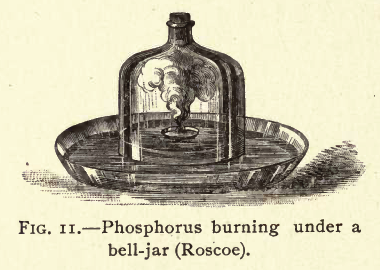
Now, phosphoric acid melts in water just as sugar does, and in a few minutes these fumes will disappear. They are beginning to melt already, and the water from the pan is rising up in the bell-jar. Why is this? Consider for a moment what we have done. First, the jar was full of air, that is, of mixed oxygen and nitrogen; then the phosphorus used up the oxygen, making white fumes; afterwards, the water sucked up these fumes; and so, in the jar now nitrogen is the only gas left, and the water has risen up to fill all the rest of the space that was once taken up with the oxygen.
We can easily prove that there is no oxygen now in the jar. I take out the cork and let a lighted taper down into the gas. If there were any oxygen the taper would burn, but you see it goes out directly, proving that all the oxygen has been used up by the phosphorus. When this experiment is made very accurately, we find that for every pint of oxygen in air there are four pints of nitrogen, so that the active oxygen-atoms are scattered about, floating in the sleepy, inactive nitrogen.
It is these oxygen-atoms which we use up when we breathe. If I had put a mouse under the bell-jar, instead of the phosphorus, the water would have risen just the same, because the mouse would have breathed in the oxygen and used it up in its body, joining it to carbon and making a bad gas, carbonic acid, which would also melt in the water, and when all the oxygen was used, the mouse would have died.Do you see now how foolish it is to live in rooms that are closely shut up, or to hide your head under the bedclothes when you sleep? You use up all the oxygen-atoms, and then there are none left for you to breathe; and besides this, you send out of your mouth bad fumes, though you cannot see them, and these, when you breathe them in again, poison you and make you ill.
Perhaps you will say, If oxygen is so useful, why is not the air made entirely of it? But think for a moment. If there was such an immense quantity of oxygen, how fearfully fast everything would burn! Our bodies would soon rise above fever heat from the quantity of oxygen we should take in, and all fires and lights would burn furiously. In fact, a flame once lighted would spread so rapidly that no power on earth could stop it, and everything would be destroyed. So the lazy nitrogen is very useful in keeping the oxygen-atoms apart; and we have time, even when a fire is very large and powerful, to put it out before it has drawn in more and more oxygen from the surrounding air. Often, if you can shut a fire into a closed space, as in a closely-shut room or the hold of a ship, it will go out, because it has used up all the oxygen in the air.
So, you see, we shall be right in picturing this invisible air all around us as a mixture of two gases. But when we examine ordinary air very carefully, we find small quantities of other gases in it, besides oxygen and nitrogen. First, there is carbonic acid gas. This is the bad gas which we give out of our mouths after we have burnt up the oxygen with the carbon of our bodies inside our lungs; and this carbonic acid is also given out from everything that burns. If only animals lived in the world, this gas would soon poison the air; but plants get hold of it, and in the sunshine they break it up again, as we shall see in Lecture VII., and use up the carbon, throwing the oxygen back into the air for us to use. Secondly, there are very small quantities in the air of ammonia, or the gas which almost chokes you in smelling-salts, and which, when liquid, is commonly called "
Having now learned what air is, the next question which presents itself is, Why does it stay round our earth? You will remember we saw in the first lecture, that all the little atoms of a gas are trying to fly away from each other, so that if I turn on this gas-jet the atoms soon leave it, and reach you at the farther end of the room, and you can smell the gas. Why, then, do not all the atoms of oxygen and nitrogen fly away from our earth into space, and leave us without any air?
Ah! here you must look for another of our invisible forces. Have you forgotten our giant force, "
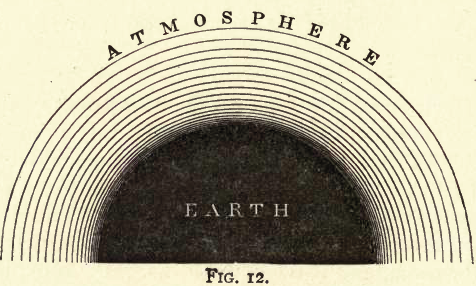
But the chief reason why the air is thicker or denser nearer the earth, is because the upper layers press it down. If you have a heap of papers lying one on the top of the other, you know that those at the bottom of the heap will be more closely pressed together than those above, and just the same is the case with the atoms of the air. Only there is this difference, if the papers have lain for some time, when you take the top ones off, the under ones remain close together. But it is not so with the air, because air is elastic, and the atoms are always trying to fly apart, so that directly you take away the pressure they spring up again as far as they can.
In this the ocean of air differs from an ocean of water, for water is neither elastic nor can it be compressed except to a very small extent. If it were otherwise the sea at great depths would be almost or quite solid under the pressure of the enormous weight of water above ; and even at a few fathoms below the surface would present great resistance to bodies passing through it. Fish or marine animals could only exist at or near the surface. At any considerable depth the compressed water would hold sunken objects embedded in it as does ice ; nothing could reach the bottom below a certain depth.
I have here an ordinary pop-gun. If I push the cork in very tight, and then force the piston slowly inwards, I can compress the air a good deal. Now I am forcing the atoms nearer and nearer together, but at last they rebel so strongly against being more crowded that the cork cannot resist their pressure. Out it flies, and the atoms spread themselves out comfortably again in the air all around them. Now, just as I pressed the air together in the pop-gun, so the atmosphere high up above the earth presses on the air below and keeps the atoms closely packed together. And in this case the atoms cannot force back the air above them as they did the cork in the pop-gun; they are obliged to submit to be pressed together.
Even a short distance from the earth, however, at the top of a high mountain, the air becomes lighter, because it has less weight of atmosphere above it, and people who go up in balloons often have great difficulty in breathing, because the air is so thin and light. In 1804 a Frenchman, named Gay-Lussac, went up four miles and a half in a balloon, and brought down some air; and he found that it was much less heavy than the same quantity of air taken close down to the earth, showing that it was much thinner, or rarer, as it is called; [* 100 cubic inches near the earth weighed 31 grains, while the same quantity taken at four and a half miles up in the air weighed only 12 grains, or two-fifths of the weight.] and when, in 1862, Mr. Glaisher and Mr. Coxwell went up five miles and a half, Mr. Glaisher's veins began to swell, and his head grew dizzy, and he fainted. The air was too thin for him to breathe enough in at a time, and it did not press heavily enough on the drums of his ears and the veins of his body. He would have died if Mr. Coxwell had not quickly let off some of the gas in the balloon, so that it sank down into denser air.
And now comes another very interesting question. If the air gets less and less dense as it is farther from the earth, where does it stop altogether? We cannot go up to find out, because we should die long before we reached the limit; and for a long time we had to guess about how high the atmosphere probably was, and it was generally supposed not to be more than fifty miles. But lately, some curious bodies, which we should have never suspected would be useful to us in this way, have let us into the secret of the height of the atmosphere. These bodies are the meteors, or falling stars.
Most people, at one time or another, have seen what looks like a star shoot right across the sky, and disappear. On a clear starlight night you may often see one or more of these bright lights flash through the air; for one falls on an average in every twenty minutes, and on the nights of August 9th and November 13th there are numbers in one part of the sky. These bodies are not really stars; they are simply stones or lumps of metal flying through the air, and taking fire by clashing against the atoms of oxygen in it. There are great numbers of these masses moving round and round the sun, and when our earth comes across their path, as it does especially in August and November, they dash with such tremendous force through the atmosphere that they grow white-hot, and give out light, and then disappear, melted into vapour. Every now and then one falls to the earth before it is all melted away, and thus we learn that these stones contain tin, iron, sulphur, phosphorus, and other substances.
It is while these bodies are burning that they look to us like falling stars, and when we see them we know that they must be dashing against our atmosphere. Now if two people stand a certain known distance, say fifty miles, apart on the earth, and observe these meteors and the direction in which they each see them fall, they can calculate (by means of the angle between the two directions) how high they are above them when they first see them, and at that moment they must have struck against the atmosphere, and even travelled some way through it, to become white-hot. In this way we have learnt that meteors burst into light at least 100 miles above the surface of the earth, and so the atmosphere must be more than 100 miles high.Our next question is as to the weight of our aerial ocean. You will easily understand that all this air weighing down upon the earth must be very heavy, even though it grows lighter as it ascends. The atmosphere does, in fact, weigh down upon land at the level of the sea as much as if a 15-pound weight were put upon every square inch of land. This little piece of linen paper, which I am holding up, measures exactly a square inch, and as it lies on the table, it is bearing a weight of 15 lbs. on its surface. But how, then, comes it that I can lift it so easily? Why am I not conscious of the weight?
To understand this you must give all your attention for it is important and at first not very easy to grasp. You must remember, in the first place, that the air is heavy because it is attracted to the earth, and in the second place, that since air is elastic all the atoms of it are pushing upwards against this gravitation. And so, at any point in air, as for instance the place where the paper now is as I hold it up, I feel no pressure, because exactly as much as gravitation is pulling the air down, so much elasticity is resisting and pushing it up. So the pressure is equal upwards, downwards, and on all sides, and I can move the paper with equal ease any way.
Even if I lay the paper on the table this is still true, because there is always some air under it. If, however, I could get the air quite away from one side of the paper, then the pressure on the other side would show itself. I can do this by simply wetting the paper and letting it fall on the table, and the water will prevent any air from getting under it. Now see! if I try to lift it by the thread in the middle, I have great difficulty, because the whole 15 pounds' weight of the atmosphere is pressing it down. A still better way of making the experiment is with a piece of leather, such as the boys often amuse themselves with in the streets. This piece of leather has been well soaked. I drop it on the floor, and see! it requires all my strength to pull it up. I now drop it on this stone weight, and so heavily is it pressed down upon it by the atmosphere that I can lift the weight without its breaking away from it.
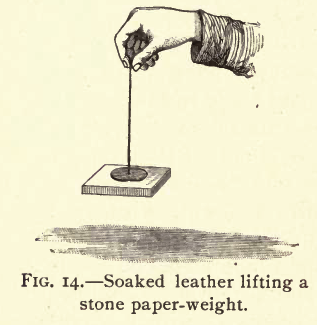
Have you ever tried to pick limpets off a rock? If so, you know how tight they cling. The limpet clings to the rock just in the same way as this leather does to the stone; the little animal exhausts the air inside its shell, and then it is pressed against the rock by the whole weight of the air above.
Perhaps you will wonder how it is that if we have a weight of 15 lbs. pressing on every square inch of our bodies, it does not crush us. And, indeed, it amounts on the whole to a weight of about 15 tons upon the body of a grown man. It would crush us if it were not that there are gases and fluids inside our bodies which press outwards and balance the weight so that we do not feel it at all.
This is why Mr. Glaisher's veins swelled and he grew giddy in thin air. The gases and fluids inside his body were pressing outwards as much as when he was below, but the air outside did not press so heavily, and so all the natural condition of his body was disturbed.
I hope we now realize how heavily the air presses down upon our earth, but it is equally necessary to understand how, being elastic, it also presses upwards; and we can prove this by a simple experiment. I fill this tumbler with water, and keeping a piece of card firmly pressed against it, I turn the whole upside-down. When I now take my hand away you would naturally expect the card to fall, and the water to be spilt. But no! the card remains as if glued to the tumbler, kept there entirely by the air pressing upwards against it.
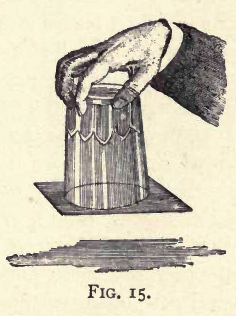
And now we are almost prepared to understand how we can weigh the invisible air. One more experiment first. I have here what is called a U tube, because it is shaped like a large U. I pour some water in it till it is about half full, and you will notice that the water stands at the same height in both arms of the tube (A, Fig. 16), because the air presses on both surfaces alike. Putting my thumb on one end I tilt the tube carefully, so as to make the water run up to the end of one arm, and then turn it back again (B, Fig. 16). But the water does not now return to its even position, it remains up in the arm on which my thumb rests. Why is this? Because my thumb keeps back the air from pressing at that end, while the whole weight of the atmosphere rests on the water at c. And so we learn that not only has the atmosphere real weight but we can see the effects of this weight by making it balance a column of water or any other liquid. In the case of the wetted leather we felt the weight of the air, here we see its effects.
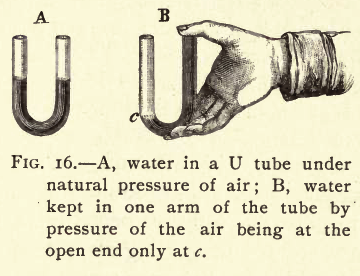
Now when we wish to see the weight of the air we consult a barometer, which works really just in the same way as the water in this tube. An ordinary upright barometer is simply a straight tube of glass filled with mercury or quicksilver, and turned upside-down in a small cup of mercury (see B, Fig. 17). The tube is a little more than 30 inches long, and though it is quite full of mercury before it is turned up (A), yet directly it stands in the cup the mercury falls, till there is a height of about 30 inches between the surface of the mercury in the cup C, and that of the mercury in the tube B. As it falls it leaves an empty space above the mercury at B which is called a

But why will it not remain more than 30 inches high in the tube? You must remember it is only kept up in the tube at all by the air which presses on the mercury in the cup. And that column of mercury C B now balances the pressure of the air outside, and presses down on the mercury in the cup at its mouth just as much as the air does on the rest. So this cup and tube act exactly like a pair of scales. The air outside is the thing to be weighed at one end as it presses on the mercury, the column C B answers to the leaden weight at the other end which tells you how heavy the air is. Now if the bore of this tube is made an inch square, then the 30 inches of mercury in it weigh exactly 15 lbs., and so we know that the weight of the air is 15 lbs. upon every square inch, but if the bore of the tube is only half a square inch, and therefore the 30 inches of mercury only weigh 7-1/2 lbs. instead of 15 lbs., the pressure of the atmosphere will also be halved, because it will only act upon half a square inch of surface, and for this reason it will make no difference to the height of the mercury whether the tube be broad or narrow. Fig. 18 is a picture of the ordinary upright barometer; the cup of mercury in which the tube stands is hidden inside the round piece of wood A, and just at the bottom of this round is a small hole B, through which the air gets to the cup.

But now suppose the atmosphere grows lighter, as it does when it has much damp in it. The barometer will show this at once, because there will be less weight on the mercury in the cup, therefore it will not keep the mercury pushed so high up in the tube. In other words, the mercury in the tube will fall.
Let us suppose that one day the air is so much lighter that it presses down only with a weight of 14-1/2 lbs. to the square inch instead of 15 lbs. Then the mercury would fall to 29 inches, because each inch is equal to the weight of half a pound. Now, when the air is damp and very full of water-vapour it is much lighter, and so when the barometer falls we expect rain. Sometimes, however, other causes make the air light, and then, although the barometer is low, no rain comes.
Again, if the air becomes heavier the mercury is pushed up above 30 to 31 inches, and in this way we are able to weigh the invisible air-ocean all over the world, and tell when it grows lighter or heavier. This, then, is the secret of the barometer. We cannot speak of the thermometer today, but I should like to warn you in passing that it has nothing to do with the weight of the air, but only with heat, and acts in quite a different way.
And now we have been so long hunting out, testing and weighing our aerial ocean, that scarcely any time is left us to speak of its movements or the pleasant breezes which it makes for us in our country walks. Did you ever try to run races on a very windy day? Ah! then you feel the air strongly enough; how it beats against your face and chest, and blows down your throat so as to take your breath away; and what hard work it is to struggle against it! Stop for a moment and rest, and ask yourself, what is the wind? Why does it blow sometimes one way and sometimes another, and sometimes not at all?
Wind is nothing more than air moving across the surface of the earth, which as it passes along bends the tops of the
It is restless because, as you will remember, its atoms are kept pressed together near the earth by the weight of the air above, and they take every opportunity, when they can find more room, to spread out violently and rush into the vacant space, and this rush we call a wind.
Imagine a great number of active schoolboys all crowded into a room till they can scarcely move their arms and legs for the crush, and then suppose all at once a large door is opened. Will they not all come tumbling out pell-mell, one over the other, into the hall beyond, so that if you stood in their way you would most likely be knocked down? Well, just this happens to the air-atoms; when they find a space before them into which they can rush, they come on helter-skelter, with such force that you have great difficulty in standing against them, and catch hold of something to support you for fear you should be blown down.
But how come they to find any empty space to receive them? To answer this we must go back again to our little active invisible fairies the sunbeams. When the sun-waves come pouring down upon the earth they pass through the air
One of the simplest examples of wind is to be found at the seaside. There in the daytime the land gets hot under the sunshine, and heats the air, making it grow light and rise. Meanwhile the sunshine on the water goes down deeper and so does not send back so many heat-waves into the air; consequently the air on the top of the water is cooler and heavier, and it rushes in from over the sea to fill up the space on the shore left by the warm air as it rises. This is why the seaside is so pleasant in hot weather. During the daytime a light sea-breeze nearly always sets in from the sea to the land.
When night comes, however, then the land loses its heat very quickly, because it has not stored it up and the land-air grows cold; but the sea, which has been hoarding the sun-waves down in its depths, now gives them up to the atmosphere above it, and the sea-air becomes warm and rises. For this reason it is now the turn of the cold air from the land to spread over the sea, and you have a land-breeze blowing off the shore.
Again, the reason why there are such steady winds, called the trade winds, blowing towards the equator, is that the sun is very hot at the equator, and hot air is always rising there and making room for colder air to rush in. We have not time to travel farther with the moving air, though its journeys are extremely interesting; but if, when you read about the trade and other winds, you will always picture to yourselves warm air made light by heat rising up into space and cold air expanding and rushing in to fill its place, I can promise you that you will not find the study of aerial currents so dry as many people imagine it to be.
We are now able to form some picture of our aerial ocean. We can imagine the active atoms of oxygen floating in the sluggish nitrogen, and being used up in every candle-flame, gas-jet and fire, and in the breath of all living beings; and coming out again tied fast to atoms of carbon and making carbonic acid. Then we can turn to trees and plants, and see them tearing these two apart again, holding the carbon fast and sending the invisible atoms of oxygen bounding back again into the air, ready to recommence work. We can picture all these air-atoms, whether of oxygen or nitrogen, packed close together on the surface of the earth, and lying gradually further and further apart, as they have less weight above them, till they become so scattered that we can only detect them as they rub against the flying meteors which flash into light. We can feel this great weight of air pressing the limpet on to the rock; and we can see it pressing up the mercury in the barometer and so enabling us to measure its weight. Lastly, every breath of wind that blows past us tells us how this aerial ocean is always moving to and fro on the face of the earth; and if we think for a moment how much bad air and bad matter it must carry away, as it goes from crowded cities to be purified in the country, we can see how, in even this one way alone, it is a great blessing to us.
Yet even now we have not mentioned many of the beauties of our atmosphere. It is the tiny particles floating in the air which scatter the light of the sun so that it spreads over the whole country and into shady places. The sun's rays always travel straight forward; and in the moon, where there is no atmosphere, there is no light anywhere except just where the rays fall. But around our earth the sun-waves hit against the myriads of particles in the air and glide off them into the corners of the room or the recesses of a shady lane, and so we have light spread before us wherever we walk in the daytime, instead of those deep black shadows which we can see through a telescope on the face of the moon.
Again, it is electricity playing in the air-atoms which gives us the beautiful lightning and the grand aurora borealis, and even the twinkling of the stars is produced entirely by minute changes in the air. If it were not for our aerial ocean the stars would stare at us sternly, instead of smiling with the pleasant twinkle-twinkle which we have all learned to love as little children.
All these questions, however, we must leave for the present; only I hope you will be eager to read about them wherever you can, and open your eyes to learn their secrets. For the present we must be content if we can even picture this wonderful ocean of gas spread round our earth, and some of the work it does for us.
We said in the last lecture that without the sunbeams the earth would be cold, dark, and frost-ridden. With sunbeams, but without air, it would indeed have burning heat, side by side with darkness and ice, but it could have no soft light. Our planet might look beautiful to others, as the moon does to us, but it could have comparatively few beauties of its own. With the sunbeams and the air, we see it has much to make it beautiful. But a third worker is wanted before our planet can revel in activity and life. This worker is water; and in the next lecture we shall learn something of the beauty and the usefulness of the "
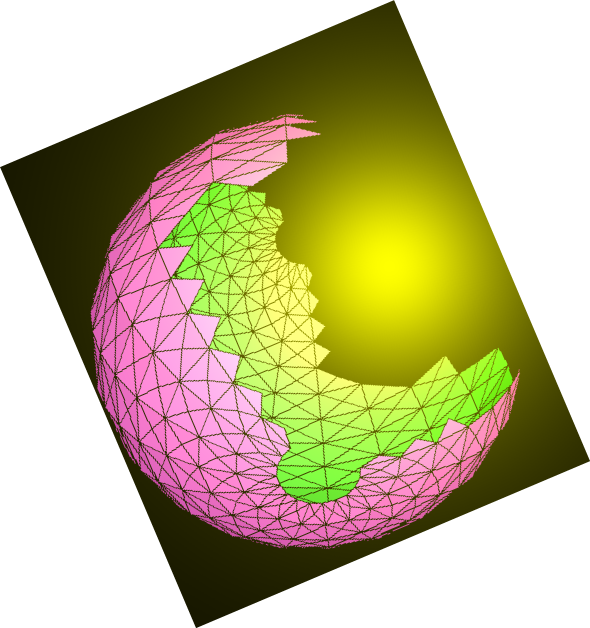
Home
N.S.B. Cosmic Center
